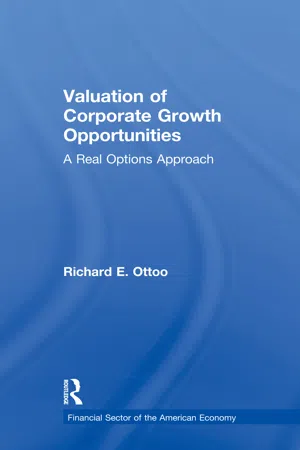Business
Present Value of Growth Opportunities (PVGO)
Present Value of Growth Opportunities (PVGO) is a financial metric used to estimate the value of a company's future growth prospects. It calculates the difference between the current market value of a company and the value of its assets if it were to be liquidated. PVGO is used by investors to determine whether a company's stock is overvalued or undervalued.
Written by Perlego with AI-assistance
Related key terms
1 of 5
2 Key excerpts on "Present Value of Growth Opportunities (PVGO)"
- Ahmed Riahi-Belkaoui(Author)
- 2000(Publication Date)
- Praeger(Publisher)
18 The prediction of this study is in contradiction with other studies that view growth opportunities as the existence of positive economic results arising from a firm's monopoly power in factor and/or output markets and that show that the larger the market power, the lower the systematic risk. 19-21 The prediction of Chung and Charaenwong 22 was, however, verified by Miles, 23 who found that beta depends on the profitability of future invest- ment, the quantity of future investments and the firm's own instantaneous return variance. Nature and Measurement 5 Contributions in the Context of Capital Budgeting Kester's contribution to the concept of growth opportunities on invest- ment opportunity set was made in the context of capital budgeting. 24 He suggested that managers think of investment opportunities as options on the company's future growth. Similarly, to call options on securities, these growth options can be viewed as real value to a firm that possesses them and capital budgetary decisions can be analyzed in those terms, as stated by Kester: Securities options give the owners the right (as distinct from an obligation) to buy a security at a fixed, predetermined price (called the exercise price) on or before some fixed date (the maturity date). By way of analogy, a discretionary opportunity to invest capital in productive assets, like plant, equipment, and brand names at some future point in time is like a call option in real assets, or a "growth option." The cost of the investment represents the option's exercise price. The value of the option (its underlying "security") is the present value of expected cash flows plus the value of any new growth opportunities expected through ownership and em- ployment of the assets. The time to maturity is the amount of time available before the opportunity disappears.- eBook - ePub
Valuation of Corporate Growth Opportunities
A Real Options Approach
- Richard E. Ottoo(Author)
- 2020(Publication Date)
- Routledge(Publisher)
Unlike well-established companies, most of the start-up and emerging firms have limited track records, making their valuation very difficult. In finance literature, most businesses are valued as going concerns with the assumption that management is expected to make continued future investments. The level of investment made at each stage of the life of the firm is determined by the net present value that is expected to accrue such that the return on investment exceeds the cost of capital. Investing in positive net present value (NPV) projects thus constitutes a major driving force fueling corporate growth.However, in a competitive market marked by rapid change and uncertainty, very little is known about valuing corporate growth opportunities. Consider an investment opportunity set available to a firm. If management’s decision to invest is discretionary and not automatic then the investment opportunities can only be valuable under certain contingencies and not guaranteed by any asset-in-place. The firm has an option of whether to invest or not. Thus, part of the market value of the firm is accounted for by the present value of future growth opportunities, real options, which can only be acquired if management exercises the option to invest.Inventions and technological change are the major driving forces of economic and industrial growth. At the individual firm level, this takes the form of investing in positive NPV projects. If firms are viewed as portfolios of real investment opportunities, then the most successful are those with access to the most lucrative projects. As already mentioned, growth opportunities are real growth options whose values are affected by management’s strategic investment decisions. Real growth options are not endowed on companies. They are instead acquired through competitive investments. Rather than assuming an exogenously specified distribution of positive NPV projects across firms, this study examines the process of allocation of investment opportunities across firms by valuing basic R&D investment.
Index pages curate the most relevant extracts from our library of academic textbooks. They’ve been created using an in-house natural language model (NLM), each adding context and meaning to key research topics.

